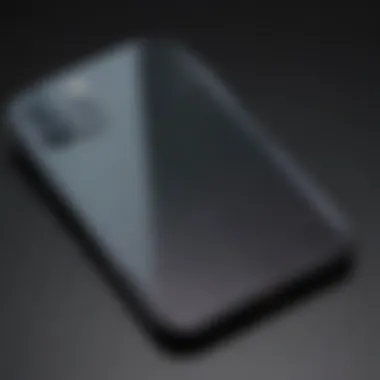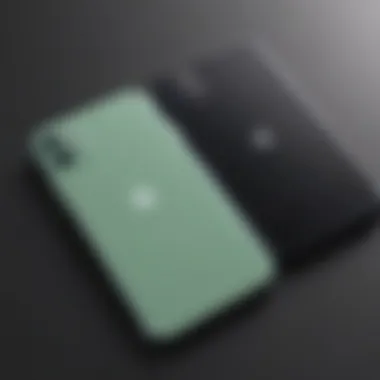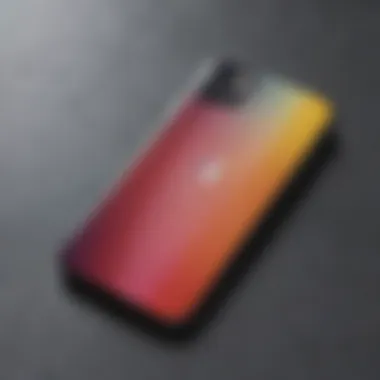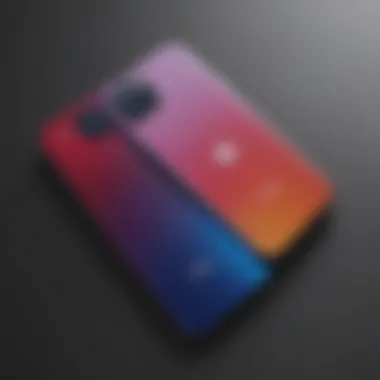Exploring iPhone 11 Color Variants and Their Impact


Intro
Colors are more than just aesthetic choices; they weave into the fabric of our daily lives. The iPhone 11, with its array of vibrant hues, offers a fascinating lens through which we can examine not only technology but also consumer behavior and cultural trends. This exploration transcends mere visual appeal. It digs into how color influences perception, evokes emotion, and shapes identity. As smartphones become extensions of ourselves, the colors we choose to adopt can say a lot about who we are and what we value.
Each color variant of the iPhone 11 embodies a personality of its own, from the bold and lively to the calm and subdued. Apple has been known for prioritizing form alongside function, ensuring that their devices do not just perform well but also fit seamlessly into the lifestyle they cater to. In the scope of this discussion, we’ll unpack not just the shades available but also dive into their implications in terms of aesthetics and consumer perception.
What does the choice of a certain color say about a user's personality? How do those choices reflect broader cultural narratives? By the end of this discussion, readers will have a clear understanding of the significance behind the iPhone 11's color variants and their enduring impact on technology and personal expression.
Prologue to the iPhone
The iPhone 11 marks a significant milestone in Apple's smartphone lineup, blending advanced technology with a bold aesthetic choice. Not only does this device showcase cutting-edge features, but it also emphasizes the importance of color—a crucial aspect in the realm of consumer electronics. This section aims to establish the groundwork for understanding why color variants matter, diving into the interplay between visual appearance and user identity.
Overview of the iPhone Release
The iPhone 11 was officially released on September 20, 2019. Positioned as an upgrade to the iPhone XR, the new device drew considerable attention both from Apple enthusiasts and casual consumers alike. With its dual-camera system, the performance boost came as a surprise, but what truly caught the public’s eye were the vibrant colors offered. The vibrant palette, including hues such as purple, yellow, green, and a classic black and white, was part of Apple's strategy to appeal to a broader audience. The strategic decision behind these colors indicated that it wasn't just about functionality; it also acknowledged the user's desire for personal expression through their devices.
Significance of Color in Technology
Colors matter more than just aesthetics; they hold meaning and can evoke emotions. Different hues can influence consumer preferences and impact purchasing decisions. In the tech world, device color can reflect individuality or even lifestyle choices.
- Psychological Effects: For instance, green often represents tranquility and connection with nature while red is associated with urgency or passion.
- Brand Identity: Apple has strategically embedded color choices into its branding, where each hue has the potential to convey a different facet of the brand personality.
"The significance of color in technology extends beyond simple preferences; it plays a key role in defining user experience and brand attachment."
The Color Palette of iPhone
The color palette of the iPhone 11 isn't just a matter of aesthetics; it's a central aspect that shapes a user's experience with the device. This section dives into the various colors available and examines their significance in the tech world. In a market where personalization is king, colors allow consumers to express their individuality and preferences. Each color variant isn’t only about appearance; it speaks volumes about brand identity, consumer psychology, and trends in technology design.
Preamble to Available Colors
The iPhone 11 was launched with a selection of six distinct colors: Black, White, Green, Yellow, Purple, and Product Red. This diverse assortment provides a spectrum that caters to different tastes and personality types. Let's take a closer look:
- Black: Always a classic, offering a sleek and sophisticated look.
- White: Reflects purity and simplicity, appealing to minimalists.
- Green: Represents a fresh and natural aesthetic, adding a touch of vibrancy.
- Yellow: Radiates energy and optimism, perfect for those who seek a standout device.
- Purple: Brings a unique flare, catering to users who prefer something distinct.
- Product Red: Not only looks good but also supports charitable causes.
Each color has its own narrative, often influenced by cultural meanings and user preferences. For instance, people who choose black may value elegance, while those opting for yellow likely desire a device that stands out from the crowd.
Visual Appeal and Design Choices
Color choices in the iPhone 11 significantly impact its visual appeal. The thoughtful selection of hues complements the device's design, enhancing user interaction. A few elements to consider:
- Contrast and Clarity: Colors are chosen not just for aesthetic value but also how they affect the visibility of text and icons on the screen. For example, a darker color like black or green can help white text pop, improving readability.
- Surface Finish: The glossy finish on the iPhone 11 enhances how light interacts with color, making it appear dynamic. This interaction can change the perceived color depending on the angle it is viewed from.
"Color is a force. It serves as a vehicle for communication, influencing our thoughts and feelings in profound ways."
- Market Trends: In recent years, the smartphone market has seen a rise in consumers seeking vibrant colors, especially among younger demographics. The iPhone 11's palette reflects this trend, making it not just a tech gadget but also a fashion statement.
Detailed Examination of Color Options


When it comes to smartphones, the color options available often hold as much importance as the technical specifications. The iPhone 11 offers a range of colors that do more than just provide aesthetic appeal; they cater to different consumer preferences and cultural contexts. This section seeks to explore these color variants in detail, highlighting their significance in the broader market landscape. Color, after all, plays a pivotal role in consumer decision-making and personal expression.
Black: The Classic Choice
Market Trends of Black Devices
Black is often seen as a timeless choice in technology. One of the most striking characteristics of black devices is their versatility. They match well with any outfit, blend into various environments, and are less prone to showing wear and tear compared to lighter shades. Over the years, statistics have shown that black smartphones tend to dominate sales. This is due to the notion that black conveys sophistication and power.
The unique feature of black's universal appeal stands out in the iPhone 11 lineup. Many users prefer to opt for black, feeling it projects confidence and a level of seriousness. While there might be concerns about it being too common, the market trend clearly shows that black remains a beloved color choice for many consumers.
Psychological Implications of Black
The color black carries a host of psychological meanings. It is often associated with elegance, authority, and even mystery. In terms of consumer behavior, choosing black can reflect a user’s desire for both simplicity and luxury. For the tech enthusiast, a black iPhone may represent a sensibility that knows what it wants.
This psychological backing adds depth to the popularity of black devices. However, it can also be a double-edged sword, as opting for black might make users feel they are blending into the crowd. Despite this, the color's striking nature often outweighs its potential downsides.
White: The Pure and Simple
Associations with Elegance
White stands as a symbol of purity and simplicity. In the realm of technology, it suggests innovation and a fresh perspective. White devices often evoke a clean and uncluttered look, appealing to consumers who gravitate towards minimalism.
The iPhone 11 in white taps into this desire for straightforward elegance. It signifies a clean slate, free from distractions, making it an alluring option for many. The unique aspect of white devices is their ability to attract attention without being loud or ostentatious.
Consumer Preferences for White Devices
Consumer surveys reveal that many people lean towards white phones, associating them with a modern, chic lifestyle. This choice indicates a desire for originality in an otherwise colorful world. It stands out not through flamboyance but through its understated charm.
Although some may argue that white is not unique enough, it is precisely this characteristic that allows it to maintain its appeal in a crowded marketplace.
Green: A Refreshing Variant
Symbolism of Green in Tech
Green represents renewal and nature, making it a refreshing choice in the world of smartphones. The iPhone 11's green variant taps into these associations, appealing to environmentally conscious users. Green reflects a desire for sustainability, aligning itself with tech enthusiasts who value responsible consumption.
The distinct feature of green in this context lies in its connection to eco-friendly living. Consumers increasingly regard their device's color as a reflection of their values, making green a bold statement beyond its visual appeal.
Target Demographics for Green Users
The demographic for green devices typically includes younger users who resonate with eco-conscious ideals. This group values authenticity and wants their choice to echo their lifestyle choices.
However, green phones may not be everybody's cup of tea, as traditionalists may prefer safer options. Still, the allure of green continues to captivate a specific segment of the market eager for innovation in both function and aesthetic.
Yellow: Bright and Bold
The Impact of Color Brightness
Yellow is perhaps one of the most striking choices for the iPhone 11. It evokes feelings of happiness and energy, acting as a beacon of positivity. The brightness of yellow can significantly impact consumer perception, suggesting cheerfulness and creativity.


The unique feature of bright colors like yellow is their ability to make a lasting impression. While some might feel it is too loud, studies indicate that devices in bright shades often attract intending buyers quickly and decisively.
Market Reception of Yellow Phones
The reception of yellow smartphones has proven to be mixed. While some adore it for standing out, others hesitate due to its boldness. However, many see yellow as a chance to express individuality in a sea of black and white devices.
So, it might not be the most popular choice, but it surely makes a statement.
Purple: A Touch of Uniqueness
Trends towards Unorthodox Colors
Purple is often seen as the color of creativity and uniqueness. As such, it occupies a distinct space in the smartphone market, representing those who wish to break free from convention. The iPhone 11's purple variant has caught the eye of many, symbolizing a willingness to embrace one's individuality.
The unique feature of this color lies in its rarity within tech. While less common, it appeals to those looking for something different. This choice often signifies bravery and an appetite for innovation.
Cultural Influences of Purple in Technology
Purple has rich cultural associations, often linked to sophistication and wisdom. It has carved a niche in technology for its ability to symbolize creativity and innovation.
Though not as mainstream as other colors, the appeal of purple does draw in specific demographics who value expression over conformity. It may not appeal to everyone, but its loyal fans wear their purple devices with pride.
Product Red: A Statement of Support
Charitable Implications
Product Red has gained recognition not just for its eye-catching hue but also for its mission. The endeavor supports global health initiatives, making it more than just a color variant. Choosing Product Red serves as a powerful statement of social responsibility.
The unique feature of this color choice is its dual purpose: stylish while symbolizing an important cause. It taps into consumers' desires to contribute to social change through their purchases.
Consumer Response to Cause-Related Marketing
A significant number of consumers express a favorable response to cause-related marketing strategies. Many feel encouraged to support a brand that contributes to meaningful causes.
This connection enriches the consumer experience and makes Product Red a sought-after choice, resonating with those who want to echo their values through their technology choices.
Color Impact on Consumer Behavior
The shades that envelop a smartphone, in this case the iPhone 11, tell a story that goes well beyond mere aesthetics. Color plays a pivotal role in consumer behavior, influencing choices, emotional responses, and even the perception of device value. When it comes to making a purchase, consumers often gravitate towards particular colors that resonate with their identity, lifestyle, or emotional state. Manufacturers understand this dynamic well, creating hues that not only attract but also establish brand loyalty.
- Emotional Resonance: Colors evoke feelings. For instance, a sunny yellow might grab attention, signaling optimism and energy, whereas a deep black might reflect power and elegance. This connection is not arbitrary. It’s deeply woven into psychological theories. As everyone are prone to form emotional attachments to colors, understanding this can guide marketing strategies.
- Audience Targeting: Through color, companies can segment their audience effectively. A brighter palette might appeal to a younger demographic that seeks fun and vibrancy, while neutral tones could attract more professional users who prefer understated elegance. Each color becomes a symbol, representing the ideal persona that resonates with the consumer's self-image.
Moreover, it’s significant to consider how color choices can also dictate market trends. Consumers may congregate around certain colors for limited time, and savvy marketers take note. Analyzing how colors perform in sales not only provides insights into purchasing patterns, but also into cultural shifts.
"When consumers connect emotionally to a product, they’re more likely to make a purchase. Color plays a crucial role in that emotional connection."
Understanding these elements helps in crafting a narrative around the iPhone 11 that aligns with the expectations and preferences of the consumers, transforming the mere choice of color into an integral part of the buying decision.
Aesthetic Preferences and Purchasing Decisions


When it comes to aesthetics, people often equate a color with their personal tastes or even lifestyle. Aesthetics are not merely visual; they evoke experiences and put forward an image. In the case of the iPhone 11, colors like Product Red convey vibrance and action, drawing in those who appreciate bold statements. Meanwhile, more conservative tones like white or black appeal to individuals with a preference for simplicity and elegance.
Decisions regarding which color to buy can sometimes rest on social perceptions. A group of friends might influence an individual’s choice. A vivid purple may be seen as a fun, trendy choice among certain social circles, whereas black may embody professional sensibilities.
- Social Influence: Peer perceptions and trends can sway an individual's decision. Seeing a friend flaunting their green iPhone may prompt someone to rethink their choice.
- Brand Image: The color choices impact Apple's brand ethos. Each hue can carry specific connotations—Product Red to some may symbolize commitment to a cause, while others may see black as synonymous with luxury.
As a result, aesthetic preferences drive consumer behavior, leading them not just to buy but to buy what resonates most with their identity.
Resale Value and Color Impacts
Interestingly, the color of a phone can substantially affect its resale value. Not all colors retain worth equally over time. Some hues are instantaneously more popular than others, which can affect how much consumers feel they can recoup when selling their devices. For example, the Product Red variant often garners high interest not just for its distinct hue, but also for its association with a larger cause, translating to a stronger aftermarket performance.
- Market Demand: Colors that align with current trends may naturally have higher resale values. A specific shade could become the talk of the town, spiking demand and making those units more valuable.
- Timelessness vs. Trends: Classic colors like silver, black, or white tend to hold their resale value longer than more trendy shades. As such, consumers might consider not only their immediate preference but also the future desirability of the color they select.
All of these facets contribute to consumers' overall decision-making process, where color emerges not merely as a choice but as a strategic component regarding investment, lifestyle, and self-expression.
The Future of Color in Smartphone Design
The world of smartphone design has evolved significantly over the years, particularly when it comes to color. This evolution reflects not only aesthetic preferences but also deeper social and psychological trends. Color choice has become a critical player in the competitive tech market, influencing branding, consumer choices, and overall user experience. The iPhone 11, with its vibrant range of hues, showcases how colors can shape identity and impulsivity in purchasing decisions. Understanding the future of color in smartphone design is essential as it helps predict market trends and consumer expectations.
Emerging Color Trends
As we move further into the digital age, the emerging color trends show a fascinating interplay between user preference and industry standards. Colors that were once considered standard, like black and white, are now being redefined. Users are looking for unique expressions in their devices, prompting manufacturers to explore vibrant and unconventional shades. Here are a few key trends:
- Bold and Unorthodox Shades: The rise of bright blues, pinks, and even gradient colors has created a new way for users to express their individuality through smartphones. Darker shades also remain popular but in more muted and refined tones.
- Sustainable Colors: As environmental awareness grows, many consumers gravitate towards brands that reflect eco-friendliness in their color choices. Earthy tones like greens and browns are starting to gain ground, often seen as more trustworthy and relatable.
- Melange Effects: The mix of colors into gradients or holographic effects is increasingly being favored in smartphone designs. This not only adds a unique visual appeal but also tells a story through the interplay of colors.
With these trends, companies are attempting to capture a broader audience and create emotional connections through color.
Technological Innovations Influencing Colors
Technological advancements significantly influence color options in smartphones, changing how colors can be produced, displayed, and perceived. Not only do they provide new opportunities for creative expression, but they also allow for more precise color replication and personalization. Here are some innovations affecting colors in smartphones today:
- OLED and AMOLED Displays: These technologies enable manufacturers to achieve a wider color gamut and enhanced contrast ratios. Colors can appear more vibrant and eye-catching, thus attracting consumers who prioritize display quality.
- Color Calibration Technology: As users become more discerning, manufacturers have begun investing in better color calibration methods to ensure consistent color quality throughout devices. This delivers a more reliable user experience.
- Mood-Aware Technology: Some companies are researching how to create adaptable smartphone colors based on user mood, utilizing sensors to adjust the color scheme dynamically. This could revolutionize personalization, connecting users on a deeper level with their devices.
- Durability Enhancements: New materials and coatings are being developed that not only resist wear and tear but also maintain vibrant colors over time, reducing fading and preserving the aesthetic appeal of smartphones across their lifespan.
Color, hence, is no longer just a design choice but a multi-faceted element that intertwines technology, psychology, and consumer engagement.
As smartphones become more integral to our lives, their colors will further reflect personal expression and technological progress.
Finale
In wrapping up our exploration of the iPhone 11's color spectrum, it’s clear that colors are not just visual pleasures but also potent symbols that influence buying behavior and personal connection. Each hue embodies meaning that resonates with different users, reflecting their lifestyles and personal expressions. Color choice can significantly impact a device’s resale value, aesthetic appeal, and even consumer loyalty towards the brand. With every glance, an iPhone is more than a smartphone; it’s a testament to individual tastes and social impressions.
Summary of Color Insights
The journey through the color palette of the iPhone 11 reveals fascinating insights:
- Diversity: Not only does Apple offer a vibrant range, from the classic black and white to the eye-catching Yellow and the unique Product Red, but this diversity meets various market needs and cultural significance.
- Psychological Influence: Colors evoke emotions; for example, Black offers sophistication while Green provides a refreshing vibe which appeals to eco-conscious consumers.
- Consumer Impact: The decision to purchase isn’t merely based on functionality anymore; it’s about how well a device aligns with personal identity and style.
Ultimately, every color option serves as a dialogue starter—whether it’s about the tech itself or the lifestyle it represents.
Final Thoughts on iPhone 's Color Spectrum
The iPhone 11's color spectrum stands as a prime example of how technology and art intertwine seamlessly in modern consumer electronics. By tactfully incorporating color variations into their lineup, Apple has succeeded in blurring the lines between device and personal expression. In a world dominated by digital identity, the colors we choose for our smartphones hold stories and signify who we are. This thoughtful approach to color not only enhances user experience but also fosters a sense of community among users—one that appreciates individuality and shared values.
As trends evolve, the future of smartphone design will likely continue to delve into color innovation, merging aesthetic and practicality in new ways. The iPhone 11 serves not just as a product, but as a cultural artifact reflecting the myriad hues of human experience.



